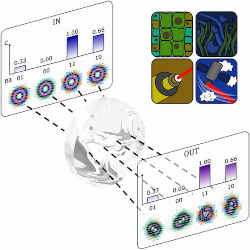
Optical communications—the backbone of the Internet—use modulated lasers to transmit over 100 different colored channels (using wavelength-division multiplexing), each moving data at 100 gigabits per second. Multi-bit encoding modes—instead of just 1s and 0s—have been proven in the lab to increase throughput even further, but all suffer from errors introduced by noise in the channels, especially over free-space channels such as those connecting satellites, submarines, or even living cells, according to researchers at South Africa's University of the Witwatersrand(Wits).
Now Wits' researchers have demonstrated a mode-division multiplexing (MDM) scheme using a quantitative measure for a vector (polarized) beam's purity, its vector-quality factor (technically, its polarization separability) as the information carrier that can encode not just 1s and 0s, but countless modes of vector light virtually unaffected by channel noise.
Observed optical communications expert Alan Willner, a Distinguished Professor in the electrical and computer engineering department of the University of Southern California (USC), "The Wits' group has made a significant contribution to the optical communications field. They importantly show researchers worldwide how to transmit multi-level digital information using a beam encoded with a specially tailored polarization distribution whose data is relatively unaffected by turbulence." Willner said this development "has the potential to keenly impact many different types of optical links, especially those that are degraded by turbulence, which the R&D community has great interest in solving."
After propagating through a noisy channel (including long-distance fibers, atmospheric turbulence, underwater turbulence, or even transparent cellular material), the intensity and polarization profiles of the vector beams are distorted, while the vector-quality factor is left unaffected, according to the Wits researchers.
The technique works by modulating the vector-quality factor instead of the amplitude of a laser, using optical components including lenses, half-wave plates, Wollaston prisms, linear polarizers, digital micro-mirrors, and photodiodes, all of which could be integrated on the same chip as the laser, according to Willner.
The results, according to the researchers, are not plagued by noise in the channel since, unlike other MDM encoding schemes, the vector-quality factor is invariant, does not suffer from significant crosstalk, can be used with existing wavelength-division multiplexing systems, and its multi-bit information capacity—determined by how many levels between 0 to 1 can be faithfully detected—is limited only by the sensitivity (noise floor) of the receiver's detector.
"Our results suggest that you can divide the range of 0 to 1 into as many levels as you like, only limited by the sensitivity of the detector you use. We used very cheap detectors for proof-of-concept tests, hence encoded an alphabet of 50 levels—instead of just 1s and 0s—but the alphabet can encode thousands of levels with the correct detector technology," said the University of the Witwatersrand's Andrew Forbes.
The insatiable appetite for higher-speed optical communication has prompted many other research groups to explore multi-bit alternatives to just 1 and 0 encodings, including many alternative mode division multiplexing schemes. For instance, French researchers demonstrated mode division multiplexing in optical fibers as far back as 1982, but only in the lab at 10-meter lengths. Improvements to over a kilometer were demonstrated recently by Chinese researchers. However, according to Forbes et.al., even these successful mode division multiplexing techniques are limited by in-channel noise that distorts the modal patterns being transmitted, thus introducing errors in their detection. Alternatively, extracting instead the invariant quantum inspired metric—its vector-quality factor as the information carrier—makes its transmission impervious to channel noise. In fact, according to the researchers, their invariant vector-quality factor can scale the number of modes between 0 and 1 right up to the noise floor of the detector being used, regardless of the channel noise.
"The idea is to use the non-separability of vectorial light, which can vary from 0 (completely separable) to 1 (completely non-separable)—a 'quantum' measure," said Forbes. "The detector that we need for measuring this invariant property is just simple photo-diodes. This is a huge advantage because it means that one does not need complicated opto-electronics for recognizing the encoded modal patterns—just its vector-quality factor."
Competing mode division multiplexing approaches, according to Forbes, must recognize the modal patterns as an integral part of their detection scheme, thus requiring a more sophisticated imager plus associated pattern-recognition algorithms that are error-prone in both fiber and free-space channels.
"The problem is that 'patterns' get distorted in non-ideal systems, which is a serious problem for communication; you send an 'A' but the pattern detector thinks it is a 'B'," said Forbes. "In our approach, we can exploit the many patterns without having to recognize them. Ours is a modal approach without the penalty of having to recognize the modes, just their vector-quality factor. What gives us the edge is that our technology requires a foot in both classical communication and quantum physics, and we are one of the few groups in the world who do both."
In quantum computing, concurrence is an invariant state indicating entanglement, which has since been generalized to continuous variable states indicating separability. The Wits group applied this quantum metric to its continuous vector-quality factor as a boon to optical-communications researchers seeking to increase information capacity with multi-bit encodings that are immune to channel noise.
R. Colin Johnson is a Kyoto Prize Fellow who has worked as a technology journalist for two decades.



Join the Discussion (0)
Become a Member or Sign In to Post a Comment